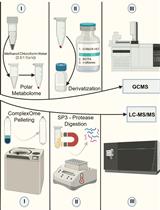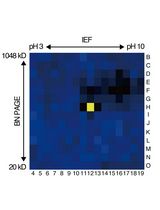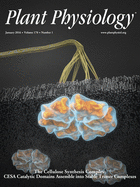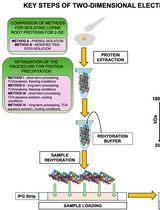- EN - English
- CN - 中文
Heterologous Expression and Purification of Catalytic Domain of CESA1 from Arabidopsis thaliana
拟南芥CESA1催化结构域的异源表达和纯化
发布: 2016年10月20日第6卷第20期 DOI: 10.21769/BioProtoc.1965 浏览次数: 7135
评审: Arsalan DaudiSibongile MafuAnonymous reviewer(s)

相关实验方案

利用SP3珠和稳定同位素质谱技术优化蛋白质合成速率:植物核糖体的案例研究
Dione Gentry-Torfer [...] Federico Martinez-Seidel
2024年05月05日 1727 阅读

基于活性蛋白质组学和二维聚丙烯酰胺凝胶电泳(2D-PAGE)鉴定拟南芥细胞间隙液中的靶蛋白酶
Sayaka Matsui and Yoshikatsu Matsubayashi
2025年03月05日 981 阅读
Abstract
Heterologous expression of plant cellulose synthase (CESA) and its purification has remained a challenge for decades impeding detailed biophysical, biochemical and structural characterization of this key enzyme. An in-depth knowledge of structure and function of CESA proteins would enable us to better understand the hierarchical structure of the plant cell wall. Here, we report a detailed, and reproducible method of purification of catalytic domain of CESA1 from Arabidopsis thaliana that was recombinantly expressed in Escherichia coli. The method relies on a two stage purification procedure to obtain the catalytic domain in monomer and trimer forms. The biochemical and biophysical data including low resolution structures of the protein have been published (Vandavasi et al., 2016). Currently the crystallization studies of this protein are underway.
[Background] Cellulose is the most important structural component of plant cell walls and constitutes the Earth’s largest source of biorenewable material, yet the mechanism of its synthesis by plants is poorly understood. The plant cellulose synthesis complex (CSC), also called a ‘rosette’ because of its hexameric appearance in electron microscope images, is a large multi-subunit transmembrane protein complex responsible for synthesis of cellulose chains and their assembly into microfibrils. The number of cellulose synthase (CESA) proteins in the CSC and the number of cellulose chains in a microfibril have been debated for many years. Structural information about CESA proteins from plants is crucial to provide answers to some of the basic questions regarding the mechanism of cellulose synthesis. However, elucidation of the structure of CESA proteins has proved difficult because they are multi-domain proteins comprised of disordered, globular, and membrane associated domains. As an alternative to pursuing structural studies of CESA holoproteins, we are developing approaches for recombinant expression of individual CESA domains (e.g., N-terminal domain, central-cytosolic domain, C-terminal transmembrane domain) in large quantities suitable for structural studies. The current protocol has been optimized for isolation of the catalytic domain of A. thaliana CESA1 as reported (Vandavasi et al., 2016). Using this protocol, it is possible to control the oligomerization state of the protein enabling structural studies of the monomer and the trimeric form of the protein. The approach described may be broadly applicable to other systems.
Materials and Reagents
- 0.2 µm filter (VWR, catalog number: 28145-501 )
- E. coli BL21-RIL (Agilent Technologies, catalog number: 230280 )
- Deionized water
- Ampicillin (VWR, catalog number: 97061-442 )
- Chloramphenicol (VWR, catalog number: EM-3130 )
- Glycerol (Sigma-Aldrich, catalog number: G5516 )
- Luria broth (EMD Millipore, catalog number: 71751 )
- Sorbitol (Sigma-Aldrich, catalog number: S1876 )
- IPTG (Teknova, catalog number: I3325 )
- Tris buffer (Sigma-Aldrich, catalog number: 252859 )
- Sodium deoxycholic acid (Geno Technology, catalog number: DG090 )
- Nonidet (Sigma-Aldrich, catalog number: I8896 )
- Sodium chloride (NaCl) (Sigma-Aldrich, catalog number: S9888 )
- Lysozyme (VWR, catalog number: CA-EM5960 )
- β-mercaptoethanol (BME) (Sigma-Aldrich, catalog number: M6250 )
- Triton X-100 (Sigma-Aldrich, catalog number: T8787 )
- CAPS buffer (Sigma-Aldrich, catalog number: C2632 )
- Sodium lauroyl sarcosine (Sigma-Aldrich, catalog number: L9150 )
- Glucose (Sigma-Aldrich, catalog number: G5767 )
- Dithiothreitol (DTT) (Sigma-Aldrich, catalog number: D0632 )
- HEPES buffer (Sigma-Aldrich, catalog number: H3375 )
- LB media supplemented with 0.25 M sorbitol (see Recipes)
- Lysis buffer (see Recipes)
- Wash buffer-1 (see Recipes)
- Wash buffer-2 (see Recipes)
- Solubilization buffer (see Recipes)
- Dialysis buffer-1 (see Recipes)
- Dialysis buffer-2 (see Recipes)
Equipment
- Glassware
- Autoclave (Panasonic, model: MLS-3781L )
- Filtering devices for sterilization (Thermo Fisher Scientific, Fisher Scientific, catalog number: 596-4520 )
- Bio hood (Labconco, model: 3440009 )
Note: This product has been discontinued. - Refrigerator or cold room
- Temperature controlled shaker incubator (Thermo Fisher Scientific, Thermo ScientificTM, model: MxQTM 6000 )
- Magnetic stirring plate (VWR, catalog number: 97042-626 )
- UV/Vis spectrophotometer (Thermo Fisher Scientific, Thermo Scientific, model: NanoDrop-2000 )
- Apparatus for SDS-PAGE (Mini-PROTEAN® Tetra vertical electrophoresis cell) (Bio-Rad Laboratories, catalog number: 1658004 )
- 400 Watt sonicator (All-Spec, BRANSON, model: S450D )
- Refrigerated centrifuge (Thermo Fisher Scientific, Thermo ScientificTM, model: RC 6 Plus )
- 10 kDa MWCO PES concentrators (Vivaproducts, model: Vivaspin® 20 )
- Superdex 200 size exclusion chromatographic column, 120 ml capacity (GE Healthcare, catalog number: 17-1069-01 )
Note: This product has been discontinued. - Akta FPLC system (or similar liquid chromatography system)
- Dialysis cassettes (Slide-A-LyzerTM dialysis cassette G2, 10 kDa MWCO) (Thermo Fisher Scientific, Thermo ScientificTM, catalog number: 87730 )
Procedure
文章信息
版权信息
© 2016 The Authors; exclusive licensee Bio-protocol LLC.
如何引用
Readers should cite both the Bio-protocol article and the original research article where this protocol was used:
- Vandavasi, V. G. and O’ Neill, H. (2016). Heterologous Expression and Purification of Catalytic Domain of CESA1 from Arabidopsis thaliana. Bio-protocol 6(20): e1965. DOI: 10.21769/BioProtoc.1965.
- Vandavasi, V. G., Putnam, D. K., Zhang, Q., Petridis, L., Heller, W. T., Nixon, B. T., Haigler, C. H., Kalluri, U., Coates, L., Langan, P., Smith, J. C., Meiler, J. and O'Neill, H. (2016). A structural study of CESA1 catalytic domain of Arabidopsis cellulose synthesis complex: evidence for CESA trimers. Plant Physiol 170(1): 123-135.
分类
植物科学 > 植物生物化学 > 蛋白质 > 结构
植物科学 > 植物生物化学 > 蛋白质 > 分离和纯化
生物化学 > 蛋白质 > 结构
您对这篇实验方法有问题吗?
在此处发布您的问题,我们将邀请本文作者来回答。同时,我们会将您的问题发布到Bio-protocol Exchange,以便寻求社区成员的帮助。
提问指南
+ 问题描述
写下详细的问题描述,包括所有有助于他人回答您问题的信息(例如实验过程、条件和相关图像等)。
Share
Bluesky
X
Copy link









